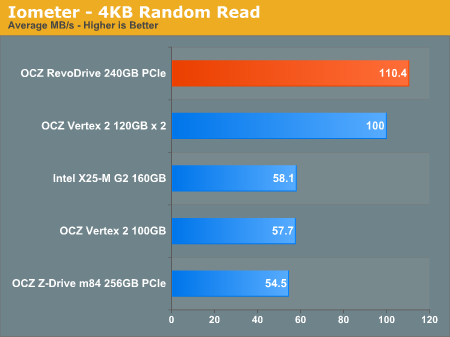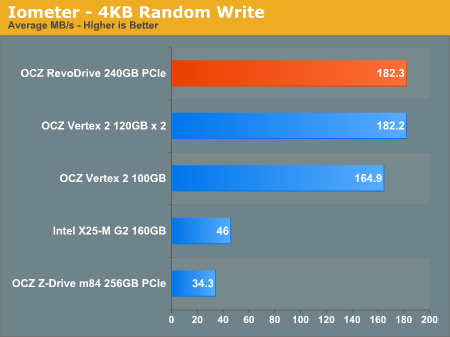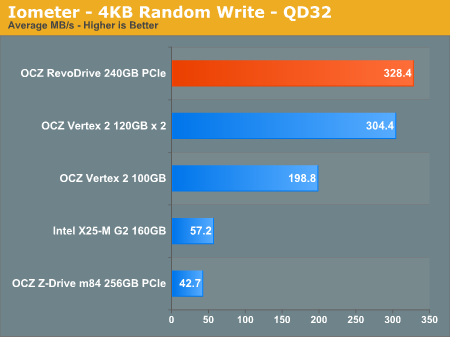OCZ's RevoDrive Preview: An Affordable PCIe SSD
by Anand Lal Shimpi on June 25, 2010 2:15 AM ESTRandom Read/Write Speed
This test reads/writes 4KB in a completely random pattern over an 8GB space of the drive to simulate the sort of random access that you'd see on an OS drive (even this is more stressful than a normal desktop user would see). I perform three concurrent IOs and run the test for 3 minutes. The results reported are in average MB/s over the entire time. All requests are 4KB aligned.

Compared to a single Vertex 2, the RevoDrive is nearly twice the performance. The Revo actually outperforms our two Vertex 2s in RAID-0 thanks to the controller on the card. This is more the exception rather than the rule however, Intel’s ICH10R is one of the fastest desktop SATA 3Gbps controllers we’ve ever seen.

At low queue depths random write performance doesn’t actually improve that much. A single Vertex 2 SSD is already running at close to peak performance here. Compared to last year’s more expensive Z-Drive m84 the performance improvement is tremendous.
Crank up the queue depth for a particularly intensive workload and you’ll see the RevoDrive separate itself from a single drive:

At over 300MB/s there’s no single SATA 3Gbps drive that could deliver this sort of performance. And honestly it’s in these high queue depth scenarios that the RevoDrive really shines. The majority of desktop users simply aren’t pushing this many IOs at a given time, but if you are the Revo won’t disappoint. A pair of Vertex 2s in RAID-0 won’t either. It all comes down to cost and preference.










62 Comments
View All Comments
shin0bi272 - Friday, June 25, 2010 - link
Please tell me you're going to give this away in your 13 year anniversary loot. I really want an SSD but Im unemployed and this one would last me a LONG time since its expandable (such a great idea btw).fwibbler - Friday, June 25, 2010 - link
Since a lot of people may be upgrading from older SSDs (like Vertex 1) it might be an idea to show one of them in a performance chart when you review the release version (in particular 2x Vertex 30GB ;-)buyaofeichu - Friday, June 25, 2010 - link
(nike-alliance).(com),Inc. We are the best online dealer,about all kinds of nike.run retailing and wholesale trade wordwidely for years. Free Shipping And Customs,Super Sale Off Retailing,With 1Week Delivery to your door.Breit - Friday, June 25, 2010 - link
wrong place pal... ;)SL_Eric - Friday, June 25, 2010 - link
Does using it on an NF200-equipped board (and the appropriate through-the-NF200 PCIe lanes) have any impact on performance?bji - Friday, June 25, 2010 - link
All this talk about upgradable flash using NAND chips on SODIMM cards inspired me to think about what the future of storage will look like.Is it likely that eventually, the SSD controllers will follow the same path that memory controllers have? Starting with external devices (which I would bet is the way that core memory was done back in the mainframe days) as we have now with external SSD controllers, then moving to controllers built into the motherboard, and finally moving to on-die controllers. All the while, with NAND flash becoming a raw commodity part that you just plug into SODIMM slots or similar on your motherboard?
So you'd buy RAM and put it in your RAM SODIMM slots, and then buy some NAND flash SODIMMS and plug those into your NAND SODIMM slots, each being handled by an on-board on on-die controller.
Is this the eventuality of solid state storage? It actually sounds really good to me. I suspect that breaking the devices apart like this, and making the SSD controllers a separate part of the system from the raw NAND flash, would allow for greater efficiency for both, and drive prices down and capacities up.
One drawback would be that the NAND flash sticks would have persisted data on them so to switch to new ones, you'd have to have somewhere to copy that data and then copy the data back onto the new sticks after you'd upgraded. Of course, that's really no different than what you have to do now when you buy a new SSD drive or (heaven forbid) spinning platter drive. The major difference being with external connector standards like SATA, you can add extra drives easily, whereas with SODIMM slots on the motherboard, you are more limited in the number of 'devices' that you can support at one time, making adding a temporary drive for the purposes of copying data around a bit harder.
allingm - Friday, June 25, 2010 - link
You know I was thinking exactly the same thing. It would be so much better if hard drive space was upgraded just like RAM. I think the RAM standard group should come up with a persistent memory storage standard.Shadowmaster625 - Monday, June 28, 2010 - link
You would just clone the SSD DIMM(s) drive image onto an external usb hard drive. Then restore the image onto the new flash DIMM(s) and, if necessary, resize the partition.nurd - Friday, June 25, 2010 - link
It seems to me that since, from the OS's standpoint, it's just a SiI 3124, if you broke the RAID and just treated it as two drives at the OS level (maybe striping them at THAT layer), you could TRIM just fine (assuming your 3124 driver supports it of course).ggathagan - Friday, June 25, 2010 - link
My guess is that you will never find TRIM support for SiL3124's.As Anand mentioned, one of the keys to the device's low cost is the use of relatively old silicon.
It would surprise me if Silicon Image was still actively doing any work on the 3124 drivers.
The latest Windows RAID drivers listed on their website are dated 2006, with a note for the 64-bit version that it supports Vista beta 2.
That part aside, TRIM support would depend on what it is about RAID that TRIM doesn't like.
Even if the controllers allows you to break up the pair to be seen as individual drives, the controller still considers each of them to be RAID0 devices.
I've no idea as to the issue between RAID and TRIM, but if the very fact that it's a RAID device disallows TRIM, then you're out of luck.
If the issue with TRIM and RAID has to do with data striping, then you might be correct, assuming that SI ever developed TRIM support for the 3124.